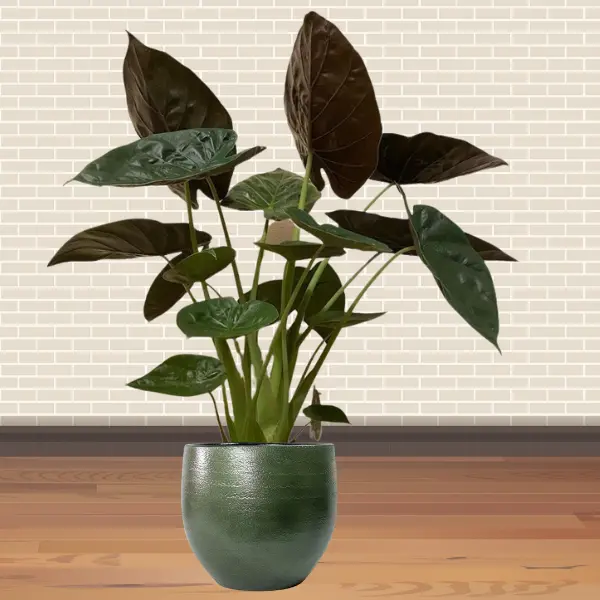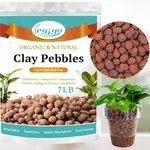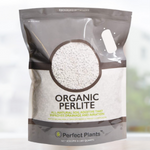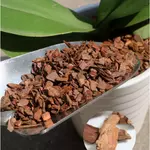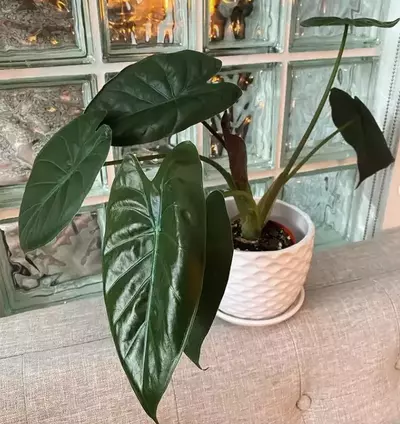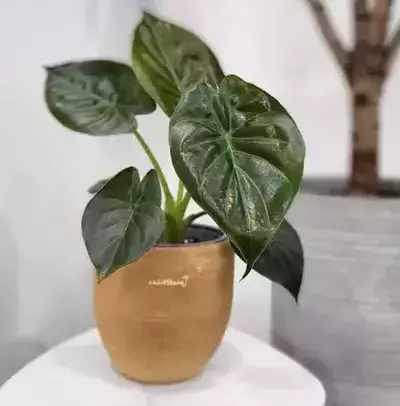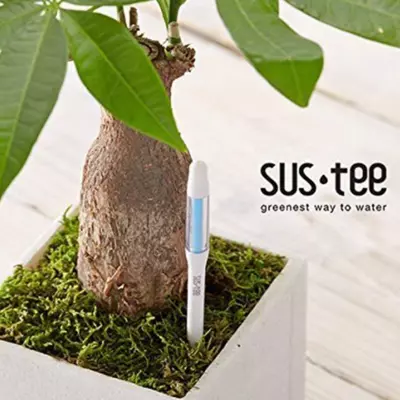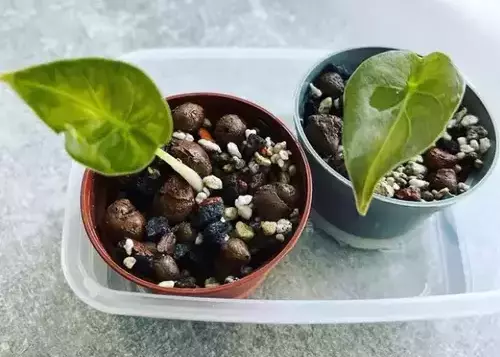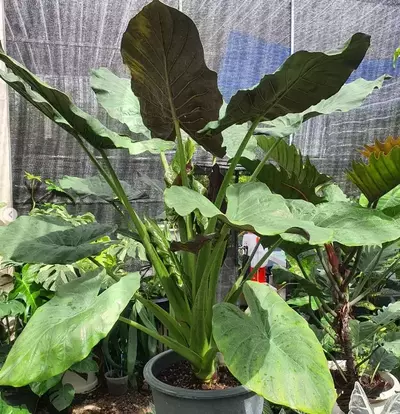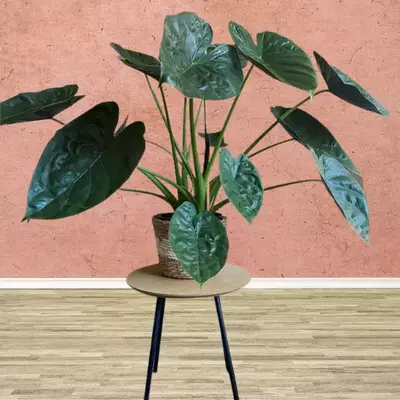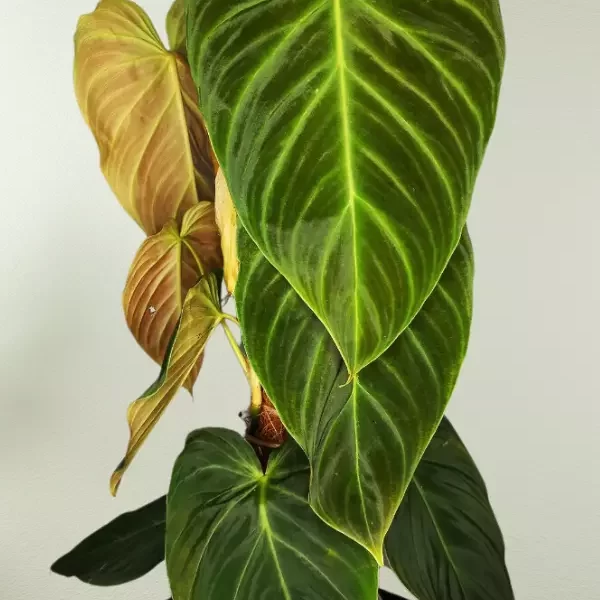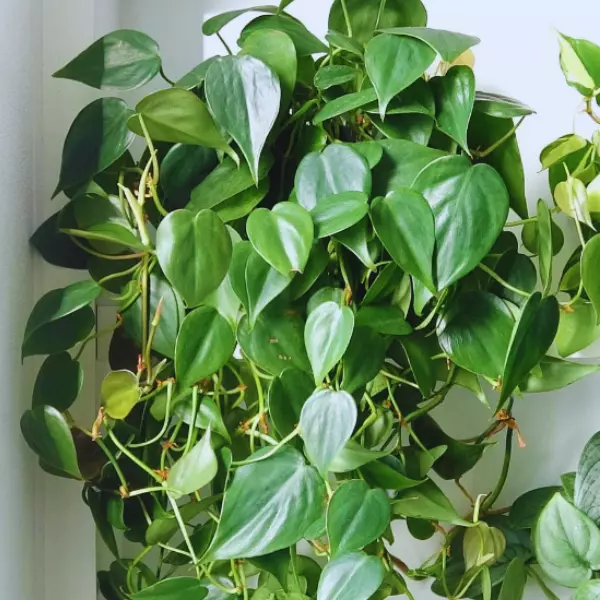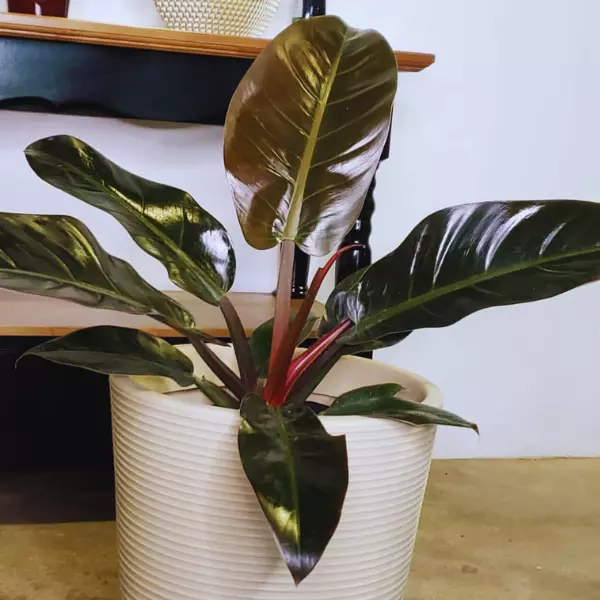Hello, Dear Gardeners,
You will find many exquisite Alocasia plants, and Alocasia Wentii is one of the stunning foliage plant. Pant lovers cherish many plants from the Araceae family, but Alocasia Wentii is adored for its huge, thick, glossy dark green and maroon foliage . This striking beauty is known by a few other names, such as Purple Umbrella, Hardy Elephant’s Ear, and New Guinea Shield. Like all other Alocasia varieties, this plant is also native to the rainforests of Southeast Asia. It was first discovered in the 1900s in Borneo and is a cross between two Alocasias, Alocasia Gageana and Alocasia Odora.
The Alocasia Wentii has gorgeous heart-shaped glossy green leaves with prominent veins and contrasting metallic maroon reverse. The richly textured tall stems complement the leaves, which adds to its overall charm and elegance.
Alocasia Wentii is an easy-to-grow plant as long as you provide it with the right growing conditions. The plant can rise up to three feet in a suitable environment. Due to its minimal maintenance, you can easily nurture this plant at home, and it will breathe life into your home with its beauty and elegance.
Allied Species: Alocasia Sarian, Alocasia Pink Dragon, Alocasia Cuprea, Alocasia Lauterbachiana, Alocasia Silver Dragon, Alocasia Stingray, Alocasia Regal Shields, Alocasia Nebula, Alocasia Maharani, Alocasia Jacklyn , Alocasia Melo, Alocasia Macrorrhiza Variegata, Alocasia Calidora
Related Products
Products | Name | Check Price |
Organic Perlite for Plants | ||
WONDER SOIL Organic | ||
Orchid Potting Bark Mulch |
Habitat & Ecology
| Botanical Name: | Alocasia Wentii |
| Family Name: | Araceae |
| Common names: | New Guinea Shield, Purple Umbrella |
| Origin | Southeast Asia |
| Plant Size | 2-3 ft. tall , 1-2 ft. wide |
| Plant type: | Flowering Perennial |
| Humidity: | 60%-80%. |
| Temperature: | 55F-85F |
| Light Need | Bright Indirect light |
| Soil | A moist and well-draining soil |
| Water | Water when the top 40% of soil is dry. |
| Pest and Diseases | Spider mites, mealy bugs ,fungal infection and root rot |
How do you care for Alocasia Wentii?
Alocasia Wentii is one of the easiest plants to grow; that’s why it makes the perfect houseplant. t It flourishes well if provided with the proper care. Place the Alocasia Wentii in an indirect light which is ideal and vital for its fast and healthy growth. The plant needs ample space as it grows, so keep it in a big room with morning sun and a sound ventilation system.
We will review everything you need to know about Alocasia Wentii care and how you can grow this plant in your home. What steps should you take to let it bloom and avoid the hitches? If you face any glitches while growing Alocasia Wentii, you might want to check this article for the care guide and solution to your problems.

Initial Care at Home
While bringing your Alocasia Wentii home, we recommend quarantining it before introducing it to other plants. Thoroughly shower the foliage to get rid of any dust and pests. Carefully inspect the leaves, especially the undersides, for any pests. Alocasia is usually spider mite magnets. If your plant is infested, treat it accordingly. During quarantine, place your Alocasia Wetti in a warm, humid spot with bright indirect sunlight and provide all the necessary conditions for this plant to acclimate. After two weeks, if you find no issue, you can introduce your Alocasia to other plants in your collection.

Humidity and Temperature Requirements:
Alocasia Wentii enjoys humid conditions like its other family members, where it grows best. The ideal humidity levels for the plant are 60% to 80% for its optimal progress.
However, it can tolerate low humidity up to 40% indoors if it receives sufficient sunlight and water. But lower humidity is not recommended as a plant might not respond to it and cannot stay healthy and fresh in this situation for long. Furthermore, in the absence of enough moisture, the plant will start showing signs of damage, such as its leaves turning brown.
If your indoors have low humidity levels, you can do the following to increase the moisture in the air.
- Set up a humidifier near the plant.
- Place it near other plants.
- Keep some water containers or pebble trays near it.
- Move the pant to humid areas such as the kitchen and bathroom.
As the Alocasia Wentii is a resident of the rainforests of Southeast Asia, it prefers a warm and humid environment like all other Araceae family members. Therefore, the ideal temperature for this plant is between 55 degrees Fahrenheit and 85 degrees Fahrenheit, which means it is more stoic to cold temperatures than other houseplants.
It can also do well up to 95 degrees, but if the temperature rises more than this, the plant might experience difficulties. But as a caring plant parent, you should pay more attention to cold weather as below 50 degrees or may go in stress, and if the temperature goes below 45 degrees, it may start shedding leaves and can go dormant at this level.
Therefore, it is vital to avoid indoor and outdoor cold environments. If you live in an area where winter is harsh, take the plant inside during that weather.

How often should I water my Alocasia Wentii?
Water is essential for plant growth. However, if you don’t understand the plant’s watering needs, there are chances that you can harm your darling plant either by overwatering or underwatering.
We know that Alocasia plants love water, but at the same time, they also like dry layers. Therefore, the best substrate for the Alocasia Wentii that is well drained and nutrient-rich, and the best time to water Wentii is when the top two inches of soil are dry.
Although the Elephant Ear likes well-draining moist soil, it also doesn’t like soggy or arid soil. Therefore, rich, balanced soil is ideal for Alocasia Wentii. Overwatering is a common issue in Alocasias; consequently, it’s imperative to check the soil before watering.
The watering needs of the plant change with the season and environment, especially the indoor climate. Your plant watering needs may be affected by air conditioning, heating, and drafts; hence, you should have a proper check on it, or it will succumb to any disease.
An important point to note here is that Alocasia Wentii gets super thirsty when it produces new foliage. Thus, when you notice that the plant is budding fresh leaves, check the soil moisture regularly to ensure that the plant is in the right atmosphere.

Light Need
Alocasia Wentii is a tropical plant that blossoms in bright indirect light. Although it enjoys adequate sunlight, it cannot endure intense and direct sun rays. As such, you can keep it in the morning and evening sun but avoid putting the plant in the afternoon sun, especially in summers, because the plant is at risk of damage. Similarly, the plant might get dormant if it doesn’t receive enough light; therefore, providing it with the required light in all seasons is vital.
Correspondingly, the right location is also significant for its development. For Wentii, east, west, or south-facing windows are ideal as they can filter out the afternoon sun rays in western or southern locations.
Likewise, keep rotating the plant every few weeks at 45 degrees for its even progression as it tends to grow in the direction of the light; when you turn the plant regularly, it receives light from all directions and develops evenly.

Soil Requirements
The two most crucial factors for Alocasia Wentii’s health are soil and watering. Both are interconnected and equally important for a plant’s growth, but it’s tough to adequately water the plant with the wrong soil mix.
Therefore, the potting soil mix should be well-draining, fertile, and aerated. The mixture should hold minimum water and, at the same time, supports aeration. You can use organic material for fertility and nutrients. The soilless mix is also suitable for Alocasia Wentii as many plants from tropical regions do remarkably well in a mix without conventional soil. You can prepare the potting mix for Alocasia Wentii with the following ingredients.
Tips for Soil
Always use well draining and moist aroid soil for your Wentii’s improved health. You can also use organic materials such as worm castings and compost in the above soil mix. They improve the fertility of the soil. We suggest using 10% of organic material in the potting mix for good results.
Alternatively you can get any good aroid mix from the market if you don’t want the hassle . Some well draining potting mix recommendations are;

Repotting of New Guinea Shield
It would help if you were gentle with your plant, as repotting is an invasive act, and it will take four to six weeks for your plant to recover from it. Luckily, you don’t have to report Alocasia Wentii often as, like other Alocasias, it also likes to grow in snug pots. Therefore, your plant still is happy in small plants and can grow big.
Repotting is suggested only when the plant is seriously root-bound. You can repot it once a year or a little more than that. Repotting can be done in any season when you see that the plant’s roots are coming out of drainage holes. This is the first indicator that the plant has outgrown the current container and needs to be moved.
The best time to repot your plant is in spring. Repotting could be pretty stressful for the plant, and it may shed a few leaves initially but don’t worry; with proper care, it will recover in a few weeks.
Always move to one pot size larger, but don’t go over that as there are chances of overwatering in larger pots because of excessive soil.

Propagation of Alocasia Wentii
Do you know that you can have more hardy Elephant Ear plants without going to the store? Yes, you can have many plants at home without buying from any nursery.
The propagation of Alocasia Wentii is simple and fun. Keep reading the below methods.
Offset Division
It’s Wentii’s most conformist method of propagation. Wentii plant grows in clumps, and you can multiply this plant by dividing the pups (baby plants ) attached from the main plant. Gently remove the clumps from the substrate. Shake off the dirt and locate the connection point of baby plant with the mother plant.
Take a sharp disinfected knife to divide the clumps of the plant ensuring each part has some roots . Now you can plant the baby plant and mother plant in separate pots. Water the newly potted plant divisions regularly and keep them in warm, humid place .You can add diluted fertilizer or some slow release granular fertilizer the soil at the potting time to aid the growth. Within few weeks you will notice new growth on your new divided plants.
Water Propagation
If the baby plant doesn’t have much roots ,you can quickly propagate your Wentii pup in the water. With the water propagation method, you can monitor the plant’s growth until transferring it into a new pot.
Split the plant as you did in the above method. Next, dip the baby clump in water, so the bottom part is 4 inches plunged in the water, and the remaining part is above the water level. Make sure to use clean and distilled water and also change the water regularly to avoid any bacterial attack.
In a few days, you will see roots in the cuttings. Transfer the plant into the appropriate soil mix when the root system matures enough for planting.

Fertilizer
Alocasia Wentii is a heavy feeder in the growing season; ensure to provide all nutrients in that season but don’t over-fertilize it as it can harm the plant. Overfertilization cause leaves discoloration. Fertilize your plant monthly in spring and summer, but the fertilizer quantity should depend on soil fertility.
Fertilizing Tips
- Organic fertilizers are safe for plants’ delicate root systems as compared to inorganic formulas.
- Flush the soil every month or two to wash away extra and unused fertilizer.
- Don’t feed during winter.

Maintenance:
Although Alocasia Wentii is a low-maintenance plant, it also requires pruning from time to time. It’s an attractive plant, but if left uncared, it can look unattractive and ugly, which surely you don’t want.
It needs regular pruning, and there could be various reasons behind it. Suppose your plant has grown too big and taking up too much space. You can control its size by pruning a few petioles.
Similarly, pruning is vital for removing yellow and old leaves as they make plants dull and unpleasant. If your plant’s leaves are fungal infected, cutting them off is better to avoid spreading infection. Sterilized equipment is recommended to protect your plant from diseases and infections.

Toxicity
Alocasia Wentii is harmful to humans, cats, dogs, and horses. The plant parts contain oxalic acid which can become extremely irritating to the skin. If the plant is ingested, the initial symptoms are an oral burning feeling, leading to vomiting, difficulty swallowing and dribbling. In some scenarios, death can happen if the swollen tissues block the breathing passage.
Therefore, keep the children and pets away from this plant. Also, use gloves during pruning and repotting.

Pests and Diseases:
Pests
This plant has large leaves, so it is an attractive spot for pests. You can expect some unwanted visitors as all Alocasias are loved by pests.
The most common pests your plant can encounter are spider mites, mealy bugs, and thrips.
Spider mites: Spider mites cause yellow or white spots on the plant’s leaves. If there is a severe infestation, you may notice sticky webbing. You can control and treat spider mites with water and soap mixture.
Mealy bugs: If your plant’s leaves have cottony clumps underside, it is likely to be attacked by mealy bugs. You can treat this with regular application of neem oil on both sides of the leaves.
Thrips: These are tiny flying insects that usually attack Alocasia Wentii. You can use neem oil and pyrethrin spray to control thrips.
Common problems
Here are some problems that your purple umbrella might face
Overwatering: This is a common issue in Alocasias. When you overwater the plant, you notice water droplets or sweat on the leaves. Another sign is that the leaves of your plant have brown spots on them. Be careful when you water the plant, as overwatering may lead to root rot.
Less Watering: It also harms your plant when it doesn’t receive the required water. You will notice wrinkled leaves and stunted growth in your plant if it doesn’t have enough water. Less watering may also cause plant death. Therefore, if you see the top two inches of soil dry, immediately water it.
Inadequate Light: We know that light is vital for the plant’s growth, and if your Wentii doesn’t receive sufficient sunlight, it can cause stunted growth. The leaves may become pale, and the Elephant Era may die soon.
Your purple umbrella needs bright and indirect sunlight and if you are growing it outside, ensure that it gets only a 4 to 5-hour morning sun.
Sunburn: Too much sunlight is also not good for your plant. It can get sunburn in case of too much light. The signs of sunburn are wrinkled leaves that will look burned on the edges. Hence, use a shade when growing it outside and avoid direct sunlight to prevent any possible damage.
Over-Fertilizing: Too many nutrients in the soil can also burn your lovely New Guinea Shield. Over-fertilizing can also kill your plant. Thus, make sure to use organic matter or water-soluble fertilizer. Also, only feed the plant in the growing season.
If you see that your plant is looking burnt, reduce the feeding. Nonetheless, you can rinse away the soil during watering to remove extra nutrients from the soil.
Diseases
The Alocasia Wentii diseases are caused by too wet soil. To avoid diseases in this plant, use well-draining and aerated soil that doesn’t lock water.
Root rot: Root rot symptoms are yellow leaves and mushy stems. If you notice these symptoms, remove the plant from the soil and cut away all damaged roots and foliage. Now report it in a fresh potting mix but avoid overwatering.
Fungal infection: The signs of fungal infection are yellow and brown leaves, and the leaves may develop back spots. Remove the infected leaves and use a fungicidal spray to treat any remaining infection. It is also recommended to cut back on watering in such cases.
Frequently Asked Questions
How Big Can Alocasia Wentii Grow?
The Alocasia Wentii can grow really big. The plant can reach a height of up to 118 inches, and it takes 2 to 5 years to reach maturity.
Do Alocasia Wentii Flower?
Yes, Alocasia Wentii flowers but not very often. Also, the flowers are not very attractive, like their foliage.
How to Grow Alocasia Wentii Outdoors?
You can grow the purple umbrella outdoors, but ensure it doesn’t receive direct sunlight. Plant it in the shade outside, where there is indirect light.
How to treat root rot for Alocasia Wentii?
Root rot is a common problem in Alocasia Wentii, caused by overwatering. If your plant is also suffering from root rot, remove it from its pot and remove the affected areas. Then plant it in a new container with a fresh soil mix. Place t close to the window and water it regularly but don’t overwater.
Should I cut off dead leaves from my Alocasia Wentii?
Yes, you can remove dead leaves by using a disinfected pruning shear. Trimming dead leaves is essential for a plant’s growth because when you remove infected or dead leaves, the plant focuses more energy on new leaves.
Where shall I place Alocasia Wentii?
The ideal location for Alocasia Wentii is where it receives plenty of bright light and is safe from exposure to direct sunlight. The ideal area for this beautiful plant is the window of your home, where it can get sufficient indirect light.
Final Words
Alocasia Wentii is an excellent houseplant because of its striking looks. It has alluring green and purple foliage, which makes it one of the gorgeous plants of the Alocasia genus. It can make your living room or drawing room more exquisite.
The purple umbrella doesn’t require much care and attention. It can grow well if provided with a forest-like environment with indirect sunlight, a warm and humid atmosphere, and adequate watering. The plant is pleased in well-draining and aerated soil and doesn’t need frequent repotting as it likes to be root bound.
But it would help if you were very careful while handling this plant as it contains calcium oxalate crystals that are toxic to humans and pets. Keep away the children and pets from Alocasia Wentii and consult the doctor immediately in case of any encounter.
It’s an excellent choice for your home as it will bring life to your space. Bring this loveliness soon if you want to impress your guests with its conspicuous beauty.
The Alocasia wentii, is an outstanding ornamental houseplant and is favorite for planr parents because of its striking green and purple leaves.
Related Posts
Philodendron Melanochrysum Care & Growing Guide
Philodendron ‘Splendid’ is a stunning hybrid of two stunning species of the Araceae family: Philodendron Melanochrysum and Verrucosum.
Philodendron Burle Marx Care & Propagation Guide
The most notable feature of the Philodendron Burle Marx is its large, glossy leaves, which come in heart-shaped or arrow-shaped variations.
Philodendron Scandens-“Sweetheart Plant” Easy Care Tips
Philodendron Scandens, often called the “Heartleaf Philodendron” or the “Sweetheart Plant” is a classic and most loved trailing houseplant.
Philodendron Erubescens ‘Imperial Red’ Care Tips
The Imperial Red Philodendron is easy to grow and can thrive well with little care and attention. Botanically known as Philodendron Erubescens.
Philodendron Ring of Fire Care & Growing Tips
Philodendron Ring of Fire is a striking plant known for its vibrant foliage and is believed a hybrid of Philodendron Wendlandii and P.Tortum.

